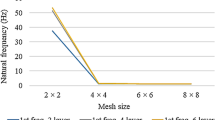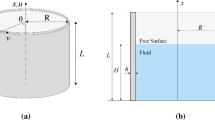Abstract
This paper deals with the development of an efficient finite element method to study the dynamic characteristics of structures containing fluid. Structural and fluid domains are discretized with 8-node plate/shell element and 20 node brick element respectively. The inviscid incompressible fluid is assumed under irrotational motion. Proper care is taken to eliminate the pressure at fluid–structure interfaces. Mass due to fluid–structure interaction is merged with structural mass and expressed the added mass in terms of inverted fluid stiffness matrix with pre- and post- multiplication of area coefficient matrix. An appropriate node numbering scheme is adopted for idealizing the structural domain and subsequently the fluid domain to gain the computational efficiency and reduction in the storage required for the added mass matrix. The adequacy of the present approach is demonstrated by considering the free vibrations of clamped cantilever plate and clamped-free open-ended cylindrical tanks and partially filled liquid tankages having common bulk head.



Similar content being viewed by others
References
Vendhan CP (2001) Fluid structure interaction under dynamic loads. Proceedings of national symposium on “Advances in Structural Dynamics and Design”, SERC, Chennai, 9–11 Jan 2001
Hinton E (1981) Numerical methods for coupled problems. International conference on numerical methods for coupled problems, Swansea, UK, 7–11 Sept 1981
Oslon LG, Bathe KJ (1985) Analysis of fluid-structure interaction—a direct symmetric coupled formulation based on the fluid velocity potential. Comput Struct 21:21–32
Everstine GC (1981) Structural analogies for scalar field problems. Int J Numer Method Eng 17:471–476
Marimuthu R, Ishaquddin M, Balakrishnan S, Sivasubramonian B, Handoo KL (2007) Simple and efficient scheme for fluid-structure interaction analysis using coupled FE-BE method. Proceedings of the International conference on Computer Aided Engineering (CAE-07), Held at IIT Madras, Chennai, 13–15 Dec 2007, pp 628–635
Marimuthu R, Ishaquddin M, Balakrishnan S, Sivasubramonian B Handoo KL (2007) Dynamic characteristics of liquid tankages by elastic analogy method. Proceedings of the International Conference on Theoritical, Applied, Computational and Experimental Mechanics (ICTACEM-2007), IIT Kharagpur, India, 27–29 Dec 2007
Ishaquddin M, Marimuthu R, Balakrishnan S, Sivasubramonian B, Handoo KL (2008) Frequency and modal pressure computation for fluid-structure interaction analysis. Proceeding of the International conference on Aerospace Science and Technology (INCAST), NAL, Bangalore, 26–28 June 2008
Marimuthu R, Nageswara Rao R, Sivasubramonian B (2010) An efficient finite element method for fluid-structure interaction problem. Proceedings of the national conference on advances in mechanical engineering, NAME-2010, JNN College of Engineering, Shimoga, 23–24 Sept 2010
Malenovsky E, Pochyly F, Pochyly L, Pohanka L, Chlud M (2011) Application of the dynamic compliance method for fluid-structure interaction. Comput Fluids 44:143–152
Hou Gene, Wang **, Layton Anita (2012) Numerical methods for fluid-structure interaction—a review. Commun Comput Phys 12(12):337–377
Pochyly F, Malenovsky E, Pohanka L (2013) New approach for solving the fluid-structure interaction eigenvalue problem by modal analysis and the calculation of steady-state or unsteady responses. J Fluids Struct 37:171–184
Hughes Kevin, Vignjevic Rade, Campbell James, De Vuyst Tom, Djordjevic Nenad, Papagiannis Lampros (2013) From aerospace to offshore: Bridging the numerical simulation gaps—simulation advancements for fluid structure interaction problems. Int J Impact Eng 61:48–63
Johannes AN (2013) Hengstler, Influence of the fluid-structure interaction on the vibrations of structures. Doctor of Sciences Dissertation, ETH Zurich, Diss. ETH No.21645
Liu Jie, Jaiman Rajeev K, Gurugubelli Pardha S (2014) A stable second-order scheme for fluid-structure interaction with strong added-mass effects. J Comput Phys 270:687–710
Gil Ho Yoon (2014) Stress-based topology optimization method for steady-state fluid-structure interaction problems. Comput Methods Appl Mech Eng 278:499–523
Li Zhe, Leduc Julien, Combescure Alain, Leboeuf Francis (2014) Coupling of SPH-ALE method and finite element method for transient fluid-structure interaction. Comput Fluids 103:6–17
Surana KS, Blockwell B, Powell M, Reddy JN (2014) Mathematical models for fluid-solid interaction and their numerical solutions. J Fluids Struct 50:184–216
Scholcz TP, vanZuijlen AH, Bijl H (2014) Space-map** in fluid-structure interaction problems. Comput Methods Appl Mech Eng 281:162–183
Irons BM (1970) A Frontal solution program for finite element analysis. Int J Numer Method Eng 2:5–32
Mazuch T, Horacek J, Trnka J, Vesely J (1996) Natural modes and frequencies of a thin clamped-free steel cylindrical storage tank partially filled with water—FEM & Measurements. J Sound Vib 193:669–690
Zienkowicz OC (1977) The finite element method, 3rd edn. McGraw-Hill, New York
Cook Robert D, Malkus David S, Plesha Michael E (1988) Concepts and applications of finite element analysis, 3rd edn. Wiley, New York
Leissa AW (1969) Vibration of Plates, NASA SP-160, 1969
Ergin A, Ugurlu B (2004) Hydroelastic analysis of fluid storage tanks by using a boundary integral equation method. J Sound Vib 275:489–513
Acknowledgments
The first author (R. Marimuthu) would like to thank his colleagues: Mr. P.V. Anil Kumar for his valuable technical support on the software development; Dr. K. Kanaka Raju, Dr. B. Sivasubramonian, Mr. K.L. Handoo for their encouragements; Mr. P.S. Veeraragavan and Mr. K. Ramakrishnan (Former Directors, VSSC) and Mr. M.C. Dathan (Director, VSSC) for permission to present the work in International Conferences and publish in Journals; Dr. K. Radhakrishnan, Chairman, ISRO for showing keen interest in the in-house developed FEAST software package in which this work is included.
Author information
Authors and Affiliations
Corresponding author
Rights and permissions
About this article
Cite this article
Marimuthu, R., Nageswara Rao, B. An efficient finite element approach to examine the free vibration characteristics of liquid tankages in space launch vehicles. Meccanica 50, 1217–1226 (2015). https://doi.org/10.1007/s11012-014-0086-8
Received:
Accepted:
Published:
Issue Date:
DOI: https://doi.org/10.1007/s11012-014-0086-8




